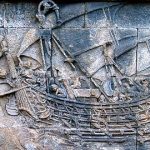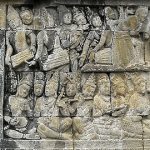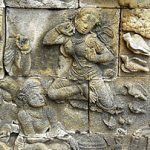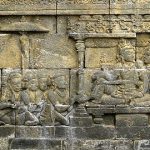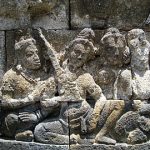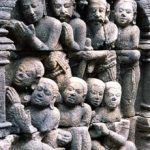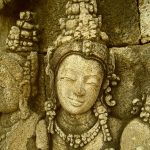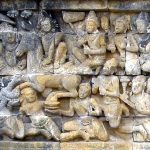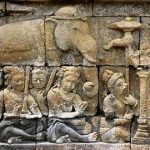Borobudur
Bhmi Sambhra Bhudhra - Mount the ten levels of bodhisattva virtue
This monument is a model of the universe and was built as a holy place to glorify Buddha as well as function as a place of pilgrimage to guide mankind from the realm of worldly lust to enlightenment and wisdom according to Buddhist teachings. Pilgrims enter via the east side and begin the ritual at the base of the temple by walking in a clockwise circle around this sacred building, while continuing to climb the next steps through the three realms of Buddhist cosmology. The three levels are Kāmadhātu (the realm of lust), Rupadhatu (the realm of form), and Arupadhatu (the realm of intangibility). On the way the pilgrims walk through a series of aisles and stairs seeing no less than 1,460 beautiful relief panels engraved on the walls and balustrades.
According to historical evidence, Borobudur was abandoned in the 14th century as the influence of Hindu and Buddhist kingdoms in Java weakened and the influence of Islam began. The world began to realize the existence of this building since it was discovered in 1814 by Sir Thomas Stamford Raffles, who was then the British Governor General of Java. Since then Borobudur has undergone a series of rescue and restoration efforts (repairs). The largest restoration project was carried out between 1975 and 1982 under the efforts of the Government of the Republic of Indonesia and UNESCO, then this historic site was included in the list of World Heritage Sites.
Borobudur is still used today as a place of religious pilgrimage; every year Buddhists who come from all over Indonesia and abroad gather at Borobudur to commemorate the Trisuci Waisak. In the world of tourism, Borobudur is the single most visited tourist attraction in Indonesia.
Etymology
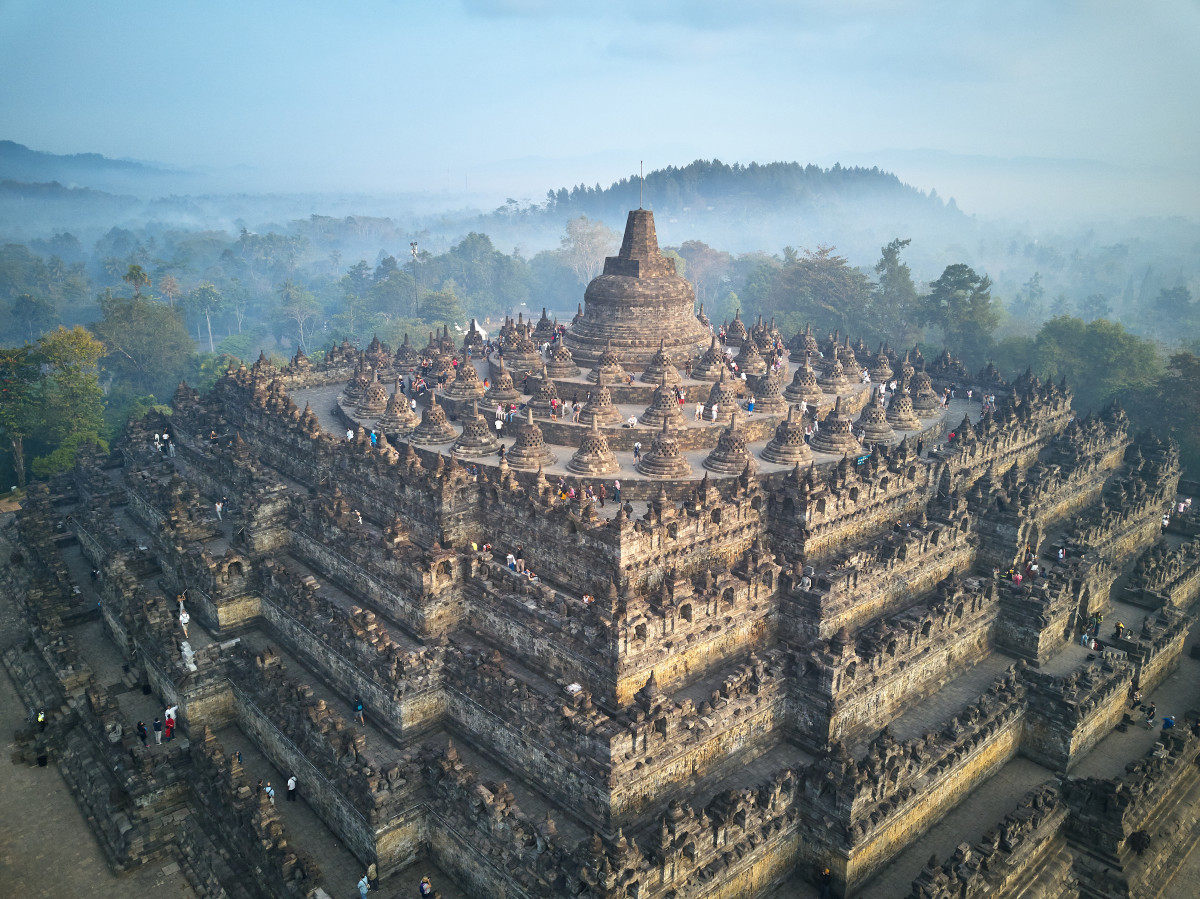 In Indonesian, ancient temples are referred to as candi; thus locals refer to “Borobudur Temple” as Candi Borobudur. The term candi also loosely describes ancient structures, for example gates and baths. The origins of the name Borobudur, however, are unclear, although the original names of most ancient Indonesian temples are no longer known. The name Borobudur was first written in Raffles’s book on Javan history. Raffles wrote about a monument called Borobudur, but there are no older documents suggesting the same name. The only old Javanese manuscript that hints the monument called Budur as a holy Buddhist sanctuary is Nagarakretagama, written by Mpu Prapanca, a Buddhist scholar of Majapahit court, in 1365.
Most candi are named after a nearby village. If it followed Javanese language conventions and was named after the nearby village of Bore, the monument should have been named “BudurBoro”. Raffles thought that Budur might correspond to the modern Javanese word Buda (“ancient”)—i.e., “ancient Boro”. He also suggested that the name might derive from boro, meaning “great” or “honourable” and Budur for Buddha. However, another archaeologist suggests the second component of the name (Budur) comes from Javanese term bhudhara (“mountain”).
In Indonesian, ancient temples are referred to as candi; thus locals refer to “Borobudur Temple” as Candi Borobudur. The term candi also loosely describes ancient structures, for example gates and baths. The origins of the name Borobudur, however, are unclear, although the original names of most ancient Indonesian temples are no longer known. The name Borobudur was first written in Raffles’s book on Javan history. Raffles wrote about a monument called Borobudur, but there are no older documents suggesting the same name. The only old Javanese manuscript that hints the monument called Budur as a holy Buddhist sanctuary is Nagarakretagama, written by Mpu Prapanca, a Buddhist scholar of Majapahit court, in 1365.
Most candi are named after a nearby village. If it followed Javanese language conventions and was named after the nearby village of Bore, the monument should have been named “BudurBoro”. Raffles thought that Budur might correspond to the modern Javanese word Buda (“ancient”)—i.e., “ancient Boro”. He also suggested that the name might derive from boro, meaning “great” or “honourable” and Budur for Buddha. However, another archaeologist suggests the second component of the name (Budur) comes from Javanese term bhudhara (“mountain”).
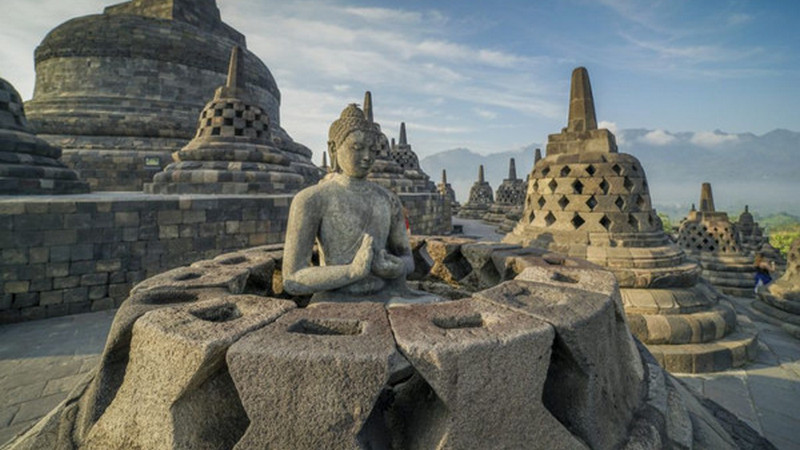 Another possible etymology by Dutch archaeologist A.J. Bernet Kempers suggests that Borobudur is a corrupted simplified local Javanese pronunciation of Biara Beduhur written in Sanskrit as Vihara Buddha Uhr. The term Buddha-Uhr could mean “the city of Buddhas”, while another possible term Beduhur is probably an Old Javanese term, still survived today in Balinese vocabulary, which means “a high place”, constructed from the stem word dhuhur or luhur (high). This suggests that Borobudur means vihara of Buddha located on a high place or on a hill.
The construction and inauguration of a sacred Buddhist building—possibly a reference to Borobudur—was mentioned in two inscriptions, both discovered in Kedu, Temanggung Regency. The Karangtengah inscription, dated 824, mentioned a sacred building named Jinalaya (the realm of those who have conquered worldly desire and reached enlightenment), inaugurated by Pramodhawardhani, daughter of Samaratungga. The Tri Tepusan inscription, dated 842, is mentioned in the sima, the (tax-free) lands awarded by Çrī Kahulunnan (Pramodhawardhani) to ensure the funding and maintenance of a Kamūlān called Bhūmisambhāra. Kamūlān is from the word mula, which means “the place of origin”, a sacred building to honor the ancestors, probably those of the Sailendras. Casparis suggested that Bhūmi Sambhāra Bhudhāra, which in Sanskrit means “the mountain of combined virtues of the ten stages of Boddhisattvahood”, was the original name of Borobudur.
Another possible etymology by Dutch archaeologist A.J. Bernet Kempers suggests that Borobudur is a corrupted simplified local Javanese pronunciation of Biara Beduhur written in Sanskrit as Vihara Buddha Uhr. The term Buddha-Uhr could mean “the city of Buddhas”, while another possible term Beduhur is probably an Old Javanese term, still survived today in Balinese vocabulary, which means “a high place”, constructed from the stem word dhuhur or luhur (high). This suggests that Borobudur means vihara of Buddha located on a high place or on a hill.
The construction and inauguration of a sacred Buddhist building—possibly a reference to Borobudur—was mentioned in two inscriptions, both discovered in Kedu, Temanggung Regency. The Karangtengah inscription, dated 824, mentioned a sacred building named Jinalaya (the realm of those who have conquered worldly desire and reached enlightenment), inaugurated by Pramodhawardhani, daughter of Samaratungga. The Tri Tepusan inscription, dated 842, is mentioned in the sima, the (tax-free) lands awarded by Çrī Kahulunnan (Pramodhawardhani) to ensure the funding and maintenance of a Kamūlān called Bhūmisambhāra. Kamūlān is from the word mula, which means “the place of origin”, a sacred building to honor the ancestors, probably those of the Sailendras. Casparis suggested that Bhūmi Sambhāra Bhudhāra, which in Sanskrit means “the mountain of combined virtues of the ten stages of Boddhisattvahood”, was the original name of Borobudur.
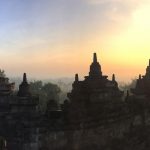
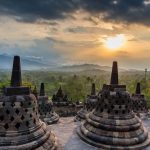
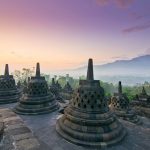
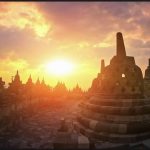
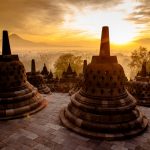
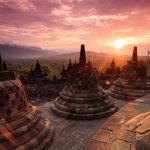






Architecture
The archaeological excavation into Borobudur during reconstruction suggests that adherents of Hinduism or a pre-Indic faith had already begun to erect a large structure on Borobudur's hill before the site was appropriated by Buddhists. The foundations are unlike any Hindu or Buddhist shrine structures, and therefore, the initial structure is considered more indigenous Javanese than Hindu or Buddhist
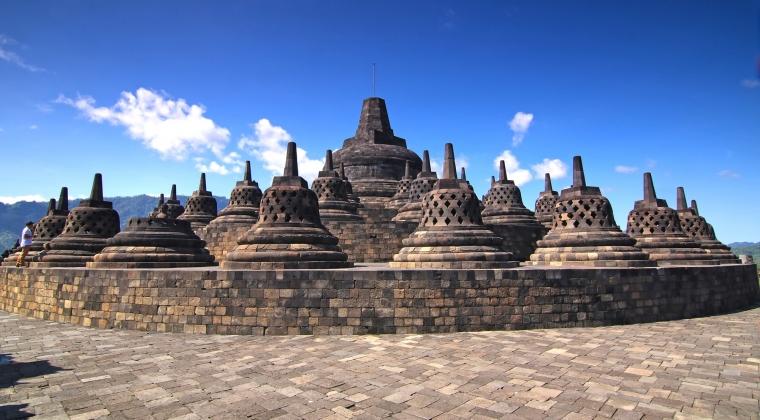 Design
Borobudur is built as a single large stupa and, when viewed from above, takes the form of a giant tantric Buddhist mandala, simultaneously representing the Buddhist cosmology and the nature of mind. The original foundation is a square, approximately 118 metres (387 ft) on each side. It has nine platforms, of which the lower six are square and the upper three are circular. The upper platform features seventy-two small stupas surrounding one large central stupa. Each stupa is bell-shaped and pierced by numerous decorative openings. Statues of the Buddha sit inside the pierced enclosures.
The design of Borobudur took the form of a step pyramid. Previously, the prehistoric Austronesian megalithic culture in Indonesia had constructed several earth mounds and stone step pyramid structures called punden berundak as discovered in Pangguyangan site near Cisolok and in Cipari near Kuningan. The construction of stone pyramids is based on native beliefs that mountains and high places are the abode of ancestral spirits or hyangs. The punden berundak step pyramid is the basic design in Borobudur, believed to be the continuation of older megalithic tradition incorporated with Mahayana Buddhist ideas and symbolism.
Design
Borobudur is built as a single large stupa and, when viewed from above, takes the form of a giant tantric Buddhist mandala, simultaneously representing the Buddhist cosmology and the nature of mind. The original foundation is a square, approximately 118 metres (387 ft) on each side. It has nine platforms, of which the lower six are square and the upper three are circular. The upper platform features seventy-two small stupas surrounding one large central stupa. Each stupa is bell-shaped and pierced by numerous decorative openings. Statues of the Buddha sit inside the pierced enclosures.
The design of Borobudur took the form of a step pyramid. Previously, the prehistoric Austronesian megalithic culture in Indonesia had constructed several earth mounds and stone step pyramid structures called punden berundak as discovered in Pangguyangan site near Cisolok and in Cipari near Kuningan. The construction of stone pyramids is based on native beliefs that mountains and high places are the abode of ancestral spirits or hyangs. The punden berundak step pyramid is the basic design in Borobudur, believed to be the continuation of older megalithic tradition incorporated with Mahayana Buddhist ideas and symbolism.
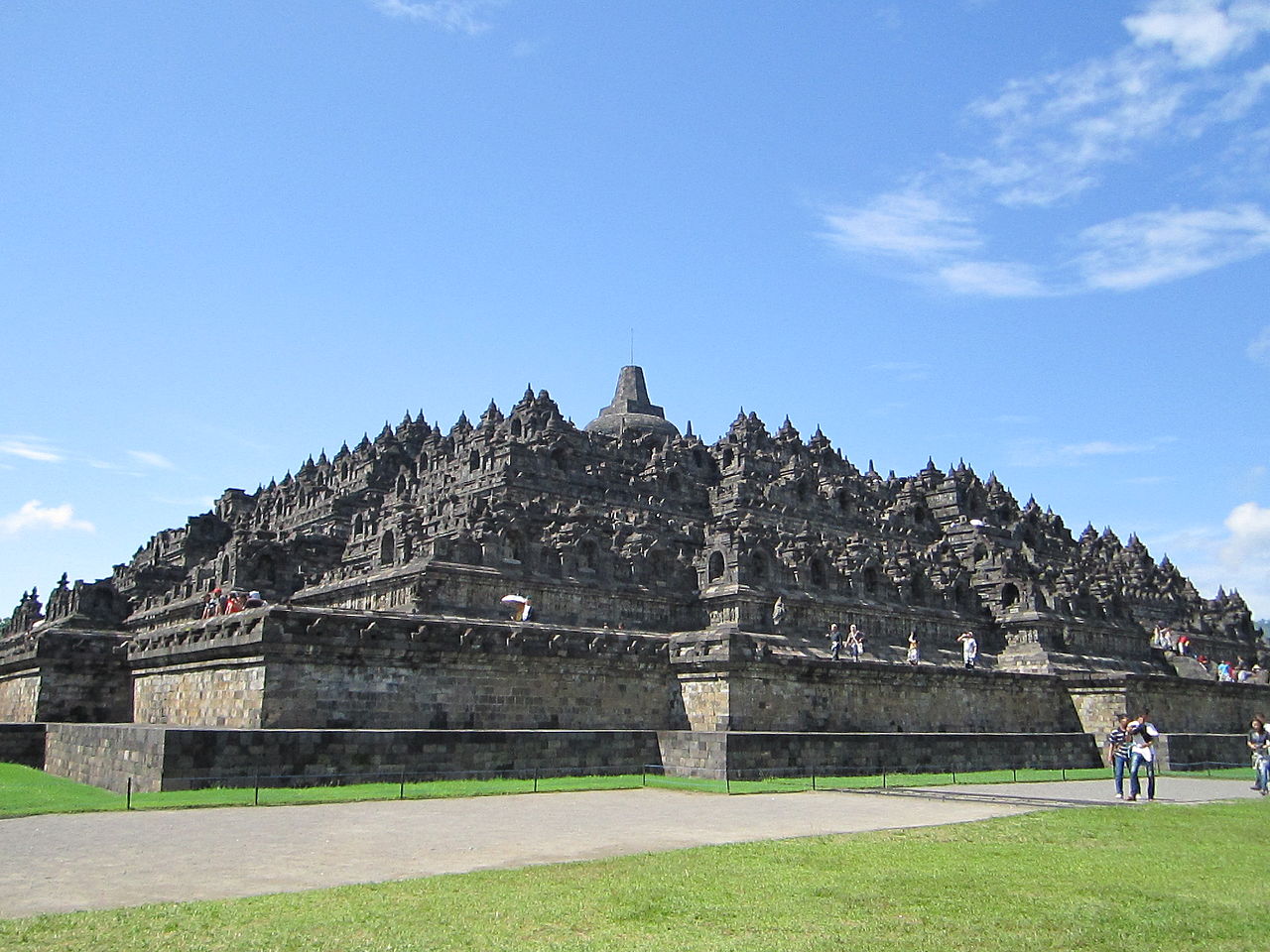 Aerial view of Borobudur, it took the form of a step pyramid and mandala plan
The monument’s three divisions symbolize the three “realms” of Buddhist cosmology, namely Kamadhatu (the world of desires), Rupadhatu (the world of forms), and finally Arupadhatu (the formless world). Ordinary sentient beings live out their lives on the lowest level, the realm of desire. Those who have burnt out all desire for continued existence leave the world of desire and live in the world on the level of form alone: they see forms but are not drawn to them. Finally, full Buddhas go beyond even form and experience reality at its purest, most fundamental level, the formless ocean of nirvana.
The liberation from the cycle of Saṃsāra where the enlightened soul had no longer attached to worldly form corresponds to the concept of Śūnyatā, the complete voidness or the nonexistence of the self. Kāmadhātu is represented by the base, Rupadhatu by the five square platforms (the body), and Arupadhatu by the three circular platforms and the large topmost stupa. The architectural features between the three stages have metaphorical differences. For instance, square and detailed decorations in the Rupadhatu disappear into plain circular platforms in the Arupadhatu to represent how the world of forms—where men are still attached with forms and names—changes into the world of the formless.
Aerial view of Borobudur, it took the form of a step pyramid and mandala plan
The monument’s three divisions symbolize the three “realms” of Buddhist cosmology, namely Kamadhatu (the world of desires), Rupadhatu (the world of forms), and finally Arupadhatu (the formless world). Ordinary sentient beings live out their lives on the lowest level, the realm of desire. Those who have burnt out all desire for continued existence leave the world of desire and live in the world on the level of form alone: they see forms but are not drawn to them. Finally, full Buddhas go beyond even form and experience reality at its purest, most fundamental level, the formless ocean of nirvana.
The liberation from the cycle of Saṃsāra where the enlightened soul had no longer attached to worldly form corresponds to the concept of Śūnyatā, the complete voidness or the nonexistence of the self. Kāmadhātu is represented by the base, Rupadhatu by the five square platforms (the body), and Arupadhatu by the three circular platforms and the large topmost stupa. The architectural features between the three stages have metaphorical differences. For instance, square and detailed decorations in the Rupadhatu disappear into plain circular platforms in the Arupadhatu to represent how the world of forms—where men are still attached with forms and names—changes into the world of the formless.
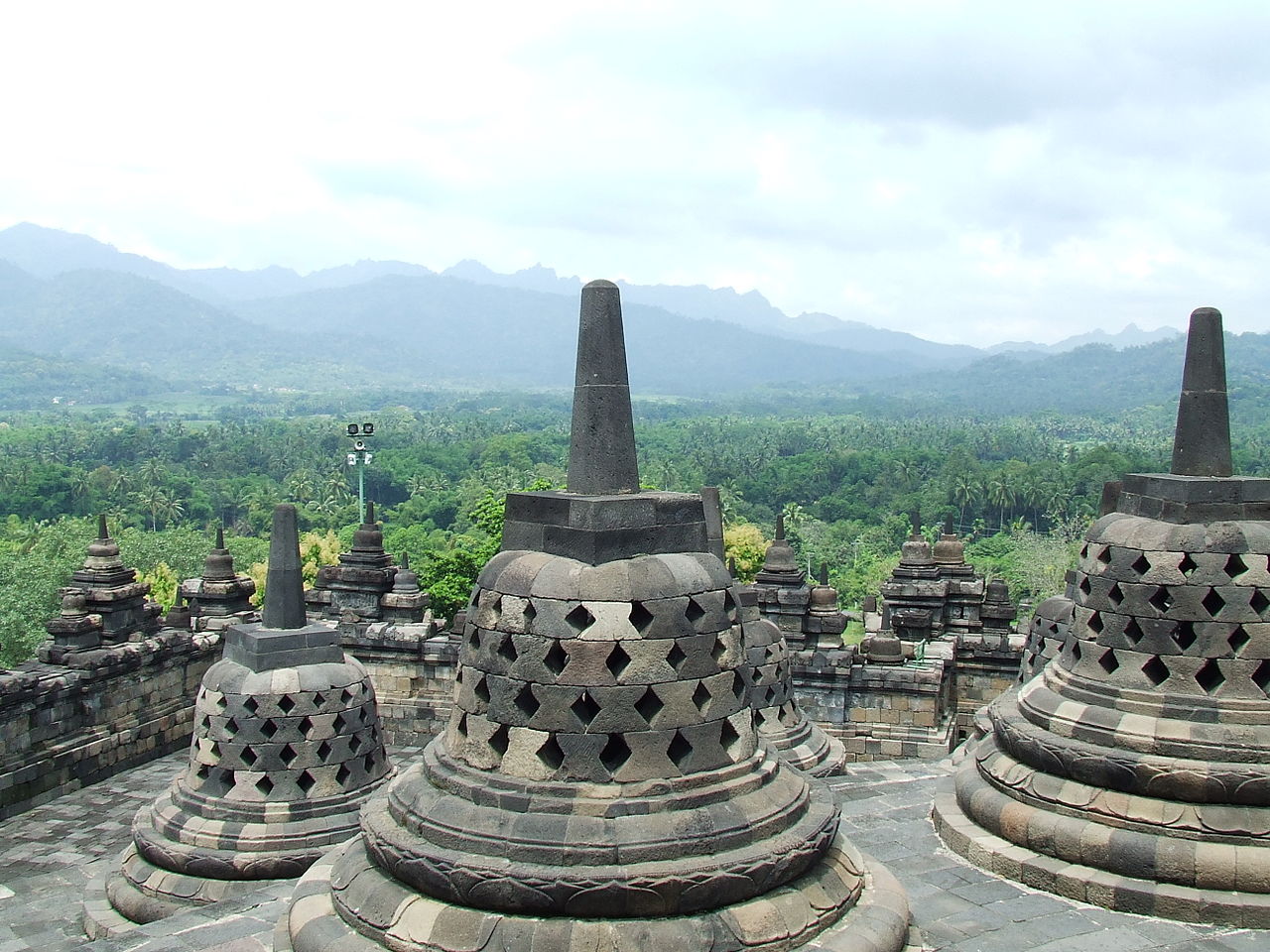 Congregational worship in Borobudur is performed in a walking pilgrimage. Pilgrims are guided by the system of staircases and corridors ascending to the top platform. Each platform represents one stage of enlightenment. The path that guides pilgrims was designed to symbolize Buddhist cosmology.
In 1885, a hidden structure under the base was accidentally discovered. The “hidden footing” contains reliefs, 160 of which are narratives describing the real Kāmadhātu. The remaining reliefs are panels with short inscriptions that apparently provide instructions for the sculptors, illustrating the scenes to be carved. The real base is hidden by an encasement base, the purpose of which remains a mystery. It was first thought that the real base had to be covered to prevent a disastrous subsidence of the monument into the hill. There is another theory that the encasement base was added because the original hidden footing was incorrectly designed, according to Vastu Shastra, the Indian ancient book about architecture and town planning. Regardless of why it was commissioned, the encasement base was built with detailed and meticulous design and with aesthetic and religious consideration.
Congregational worship in Borobudur is performed in a walking pilgrimage. Pilgrims are guided by the system of staircases and corridors ascending to the top platform. Each platform represents one stage of enlightenment. The path that guides pilgrims was designed to symbolize Buddhist cosmology.
In 1885, a hidden structure under the base was accidentally discovered. The “hidden footing” contains reliefs, 160 of which are narratives describing the real Kāmadhātu. The remaining reliefs are panels with short inscriptions that apparently provide instructions for the sculptors, illustrating the scenes to be carved. The real base is hidden by an encasement base, the purpose of which remains a mystery. It was first thought that the real base had to be covered to prevent a disastrous subsidence of the monument into the hill. There is another theory that the encasement base was added because the original hidden footing was incorrectly designed, according to Vastu Shastra, the Indian ancient book about architecture and town planning. Regardless of why it was commissioned, the encasement base was built with detailed and meticulous design and with aesthetic and religious consideration.
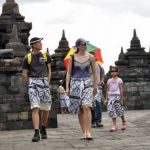


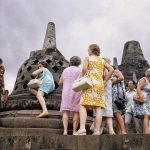
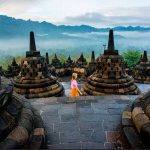



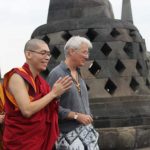

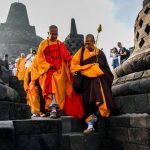
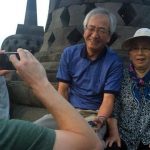
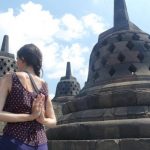
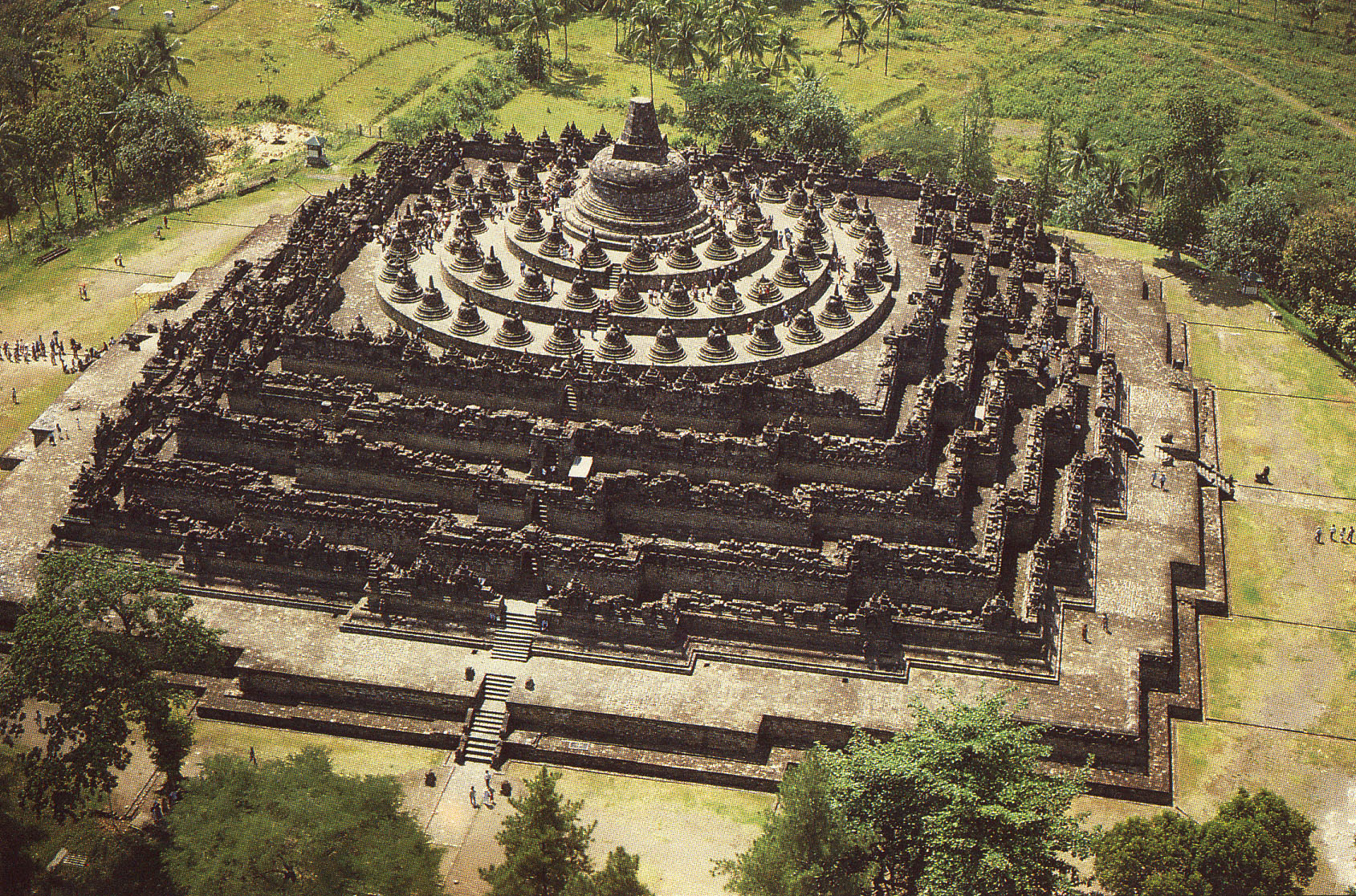 Building Structure
Approximately 55,000 cubic metres (72,000 cu yd) of andesite stones were taken from neighbouring stone quarries to build the monument. The stone was cut to size, transported to the site and laid without mortar. Knobs, indentations and dovetails were used to form joints between stones. The roof of stupas, niches and arched gateways were constructed in corbelling method. Reliefs were created in situ after the building had been completed.
The monument is equipped with a good drainage system to cater to the area’s high stormwater run-off. To prevent flooding, 100 spouts are installed at each corner, each with a unique carved gargoyle in the shape of a giant or makara.
Borobudur differs markedly from the general design of other structures built for this purpose. Instead of being built on a flat surface, Borobudur is built on a natural hill. However, construction technique is similar to other temples in Java. Without the inner spaces seen in other temples, and with a general design similar to the shape of pyramid, Borobudur was first thought more likely to have served as a stupa, instead of a temple. A stupa is intended as a shrine for the Buddha. Sometimes stupas were built only as devotional symbols of Buddhism. A temple, on the other hand, is used as a house of worship. The meticulous complexity of the monument’s design suggests that Borobudur is in fact a temple.
Building Structure
Approximately 55,000 cubic metres (72,000 cu yd) of andesite stones were taken from neighbouring stone quarries to build the monument. The stone was cut to size, transported to the site and laid without mortar. Knobs, indentations and dovetails were used to form joints between stones. The roof of stupas, niches and arched gateways were constructed in corbelling method. Reliefs were created in situ after the building had been completed.
The monument is equipped with a good drainage system to cater to the area’s high stormwater run-off. To prevent flooding, 100 spouts are installed at each corner, each with a unique carved gargoyle in the shape of a giant or makara.
Borobudur differs markedly from the general design of other structures built for this purpose. Instead of being built on a flat surface, Borobudur is built on a natural hill. However, construction technique is similar to other temples in Java. Without the inner spaces seen in other temples, and with a general design similar to the shape of pyramid, Borobudur was first thought more likely to have served as a stupa, instead of a temple. A stupa is intended as a shrine for the Buddha. Sometimes stupas were built only as devotional symbols of Buddhism. A temple, on the other hand, is used as a house of worship. The meticulous complexity of the monument’s design suggests that Borobudur is in fact a temple.
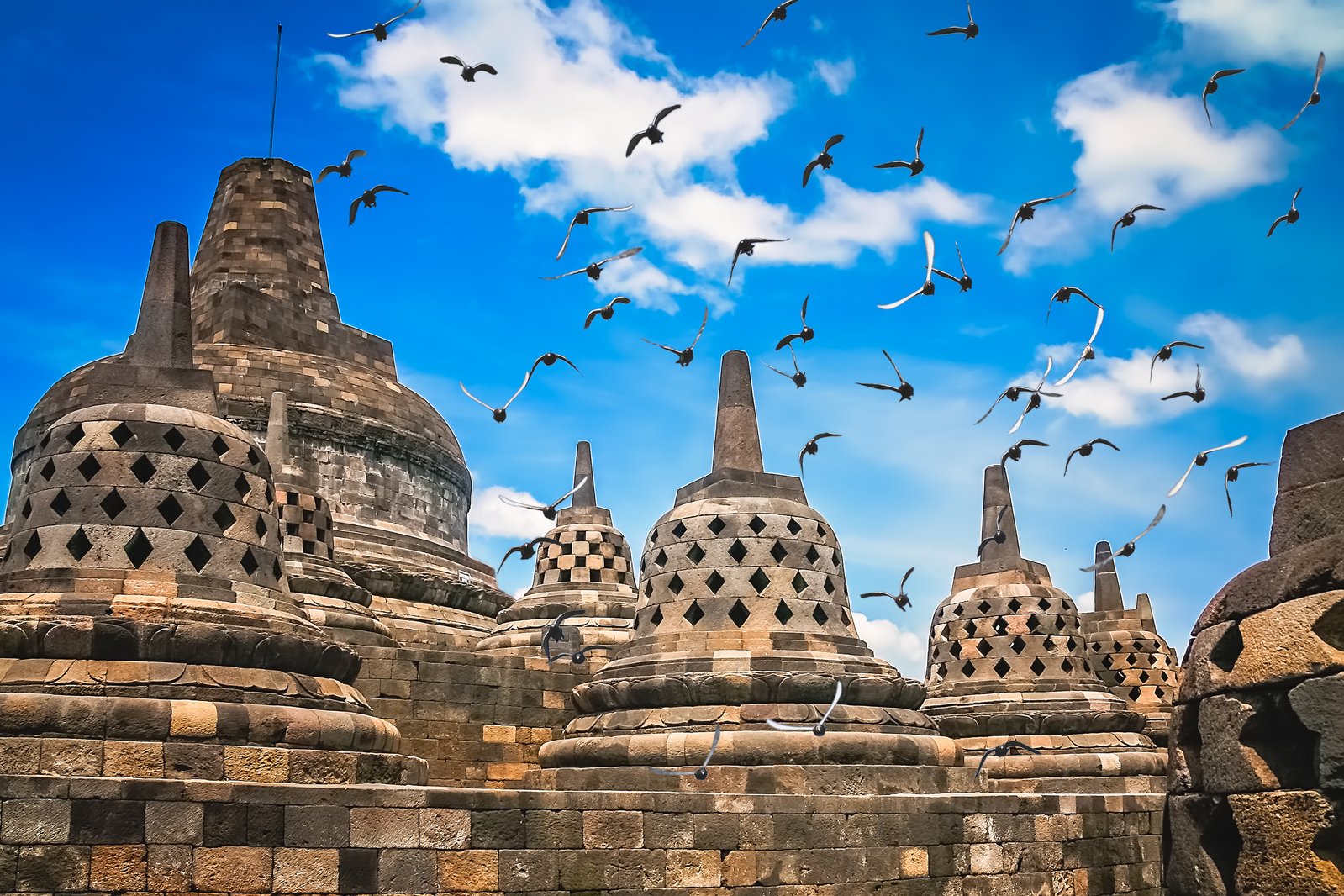 Little is known about Gunadharma, the architect of the complex. His name is recounted from Javanese folk tales rather than from written inscriptions.
The basic unit of measurement used during construction was the tala, defined as the length of a human face from the forehead’s hairline to the tip of the chin or the distance from the tip of the thumb to the tip of the middle finger when both fingers are stretched at their maximum distance. The unit is thus relative from one individual to the next, but the monument has exact measurements. A survey conducted in 1977 revealed frequent findings of a ratio of 4:6:9 around the monument.
The architect had used the formula to lay out the precise dimensions of the fractal and self-similar geometry in Borobudur’s design. This ratio is also found in the designs of Pawon and Mendut, nearby Buddhist temples. Archeologists have conjectured that the 4:6:9 ratio and the tala have calendrical, astronomical and cosmological significance, as is the case with the temple of Angkor Wat in Cambodia.
Little is known about Gunadharma, the architect of the complex. His name is recounted from Javanese folk tales rather than from written inscriptions.
The basic unit of measurement used during construction was the tala, defined as the length of a human face from the forehead’s hairline to the tip of the chin or the distance from the tip of the thumb to the tip of the middle finger when both fingers are stretched at their maximum distance. The unit is thus relative from one individual to the next, but the monument has exact measurements. A survey conducted in 1977 revealed frequent findings of a ratio of 4:6:9 around the monument.
The architect had used the formula to lay out the precise dimensions of the fractal and self-similar geometry in Borobudur’s design. This ratio is also found in the designs of Pawon and Mendut, nearby Buddhist temples. Archeologists have conjectured that the 4:6:9 ratio and the tala have calendrical, astronomical and cosmological significance, as is the case with the temple of Angkor Wat in Cambodia.
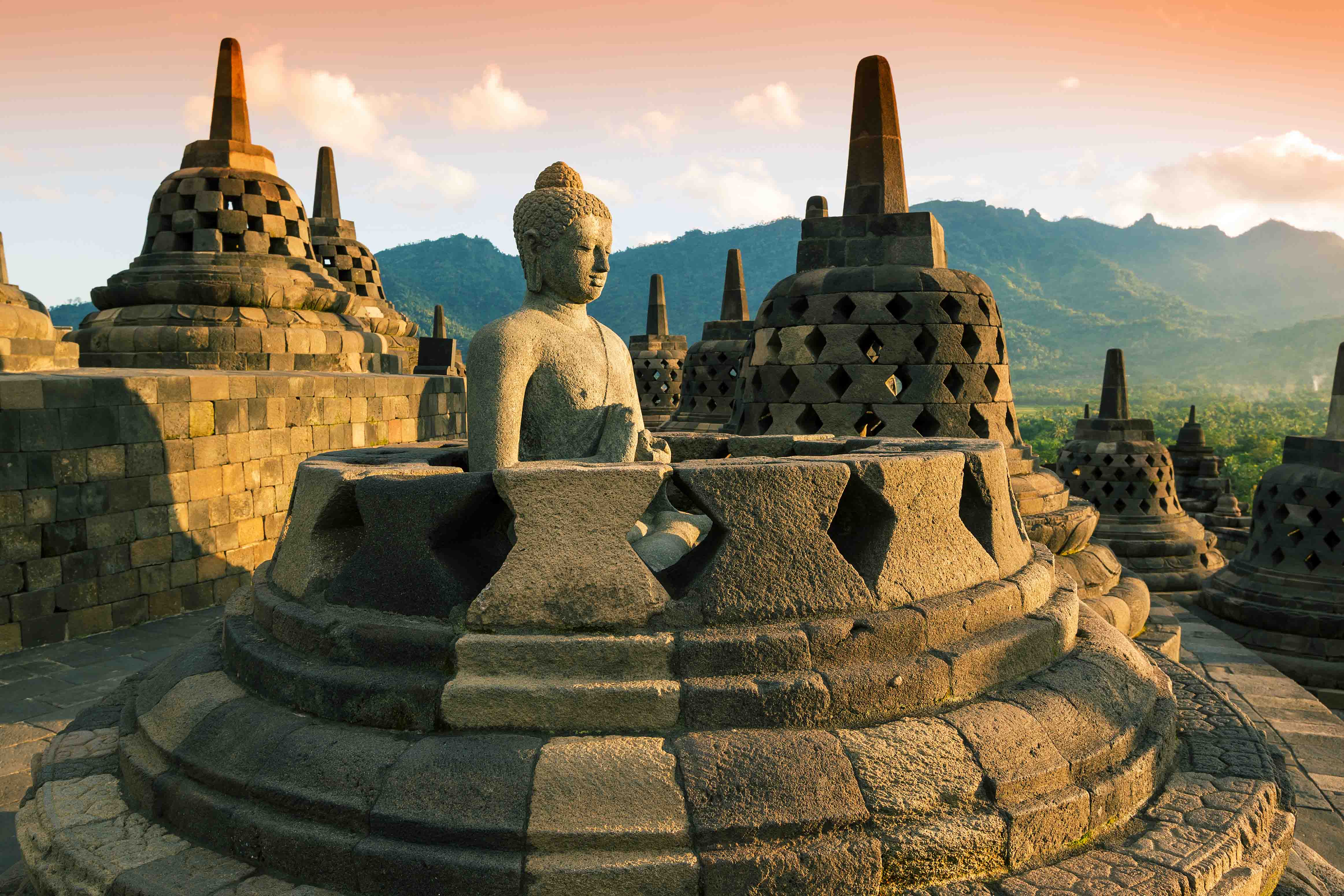 The main structure can be divided into three components: base, body, and top. The base is 123 m × 123 m (404 ft × 404 ft) in size with 4 metres (13 ft) walls. The body is composed of five square platforms, each of diminishing height. The first terrace is set back 7 metres (23 ft) from the edge of the base.
Each subsequent terrace is set back 2 metres (6.6 ft), leaving a narrow corridor at each stage. The top consists of three circular platforms, with each stage supporting a row of perforated stupas, arranged in concentric circles.
There is one main dome at the center, the top of which is the highest point of the monument, 35 metres (115 ft) above ground level. Stairways at the center of each of the four sides give access to the top, with a number of arched gates overlooked by 32 lion statues. The gates are adorned with Kala’s head carved on top of each and Makaras projecting from each side. This Kala-Makara motif is commonly found on the gates of Javanese temples. The main entrance is on the eastern side, the location of the first narrative reliefs. Stairways on the slopes of the hill also link the monument to the low-lying plain.
The main structure can be divided into three components: base, body, and top. The base is 123 m × 123 m (404 ft × 404 ft) in size with 4 metres (13 ft) walls. The body is composed of five square platforms, each of diminishing height. The first terrace is set back 7 metres (23 ft) from the edge of the base.
Each subsequent terrace is set back 2 metres (6.6 ft), leaving a narrow corridor at each stage. The top consists of three circular platforms, with each stage supporting a row of perforated stupas, arranged in concentric circles.
There is one main dome at the center, the top of which is the highest point of the monument, 35 metres (115 ft) above ground level. Stairways at the center of each of the four sides give access to the top, with a number of arched gates overlooked by 32 lion statues. The gates are adorned with Kala’s head carved on top of each and Makaras projecting from each side. This Kala-Makara motif is commonly found on the gates of Javanese temples. The main entrance is on the eastern side, the location of the first narrative reliefs. Stairways on the slopes of the hill also link the monument to the low-lying plain.

